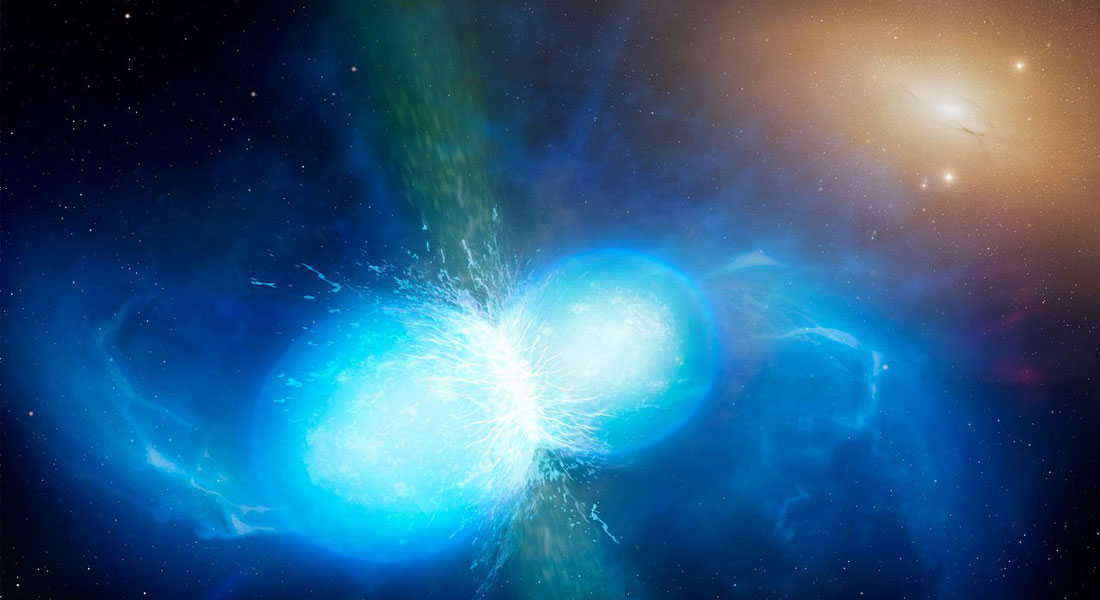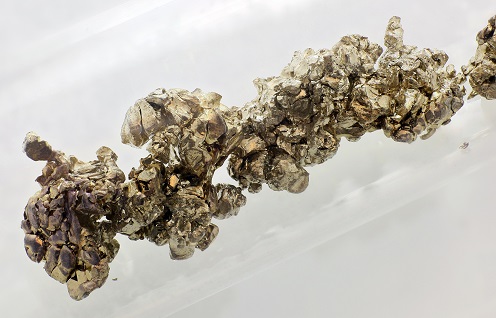The final piece in the puzzle of the origin of the elements
The first unequivocal evidence of where the heaviest elements were forged has now been found by a research group led by the University of Copenhagen. For the first time, an element heavier than iron has been clearly detected in the collision of two neutron stars, resolving one of the fundamental questions about the history of the universe.

Since the 1950s, we have known that hydrogen and helium were formed during the Big Bang, and that heavier elements up to iron are created by nuclear fusion in stars and when stars explode as supernovae. But iron is only no. 26 out of about 90 naturally occurring elements in the periodic table.
Where the other elements heavier than iron came from has long been a mystery. For some time now we have known that some of them form in the envelopes of low-mass stars, so-called AGB stars. But only half of the elements heavier than iron are created this way. So where do the rest come from?
Now a research team led by astrophysicist Darach Watson of the Niels Bohr Institute has, for the first time, found spectroscopic evidence that heavy elements are created in the explosion that happens when two neutron stars collide.
The researchers have identified the metal strontium in a spectrum from a neutron star collision observed in 2017. The result is published in the scientific journal Nature.
“Before this we were unable to identify any specific element created in a neutron star merger. There were strong indications and good circumstantial evidence that heavy elements were created in these events, but the unequivocal evidence was missing until now,” says astrophysicist Darach Watson of the Niels Bohr Institute at the University of Copenhagen, adding:
“One of the most fundamental questions about the universe has been: where do the elements of the periodic table come from? You could say that this is the last piece of the puzzle of the formation of the elements."

Unique stellar crash in 2017 helped the researchers
The only way to create substances heavier than iron is by a process called neutron capture, where neutrons penetrate an atomic nucleus - for example, an iron atom - which absorbs the neutrons, creating a new, heavier atomic nucleus and thus a new element.
Neutron capture can be either fast or slow, in the so-called r-process (rapid) or s-process (slow). About half of the substances created by neutron capture are primarily formed by the r-process. Elements formed almost exclusively by the r-process are typically very heavy and near the end of the periodic table: gold, platinum, uranium.
It is this rapid process whose location has never been established. In recent years, the scientific consensus has evolved toward the idea that much of the r-process happens when two neutron stars collide - but the definitive evidence has thus far been missing. The neutron star collision triggers a phenomenon called a kilonova, where a fraction of the neutron stars’ combined mass is released and spread into the universe in a giant explosion.
The only time the phenomenon was well-observed was in August 2017, when two neutron stars collided in a galaxy approx. 140 million light years from Earth; a collision first discovered through its gravitational wave signature and then followed-up by observatories such as the European Southern Observatory (ESO) in the Atacama desert in Chile.
The spectra gathered back then at ESO are what Darach Watson and his colleagues have been analyzing ever since. However, no one at the time was able to identify any specific elements. Using a so-called black body spectrum, Darach Watson and colleagues succeeded in reproducing the early spectra of that kilonova, in which the element strontium is prominent. Curiously, strontium is one of the lighter of the heavy elements, and this in itself is important:
"It was thought that perhaps only the heaviest elements, such as uranium and gold, formed in neutron star mergers. Now we know that the lighter of the heavy elements are also created in these mergers. And so it tells us that neutron star collisions produce a broad range of the heavy elements, from the lightest to the very heaviest,” says astrophysicist and co-author Jonatan Selsing, who until recently was a postdoc at the Niels Bohr Institute.
The researchers' next step is to try to identify more elements in the spectra of the kilonova. If successful, they expect to find elements heavier than strontium - possibly barium and lanthanum.
The research article is written by:
- Darach Watson (Niels Bohr Institute & Cosmic Dawn Center, University of Copenhagen, Denmark),
- Camilla J. Hansen (Max Planck Institute for Astronomy, Heidelberg, Germany),
- Jonatan Selsing (Niels Bohr Institute & Cosmic Dawn Center, University of Copenhagen, Denmark),
- Andreas Koch (Center for Astronomy of Heidelberg University, Germany),
- Daniele B. Malesani (DTU Space, National Space Institute, Technical University of Denmark, & Niels Bohr Institute & Cosmic Dawn Center, University of Copenhagen, Denmark),
- Anja C. Andersen (Niels Bohr Institute, University of Copenhagen, Denmark),
- Johan P. U. Fynbo (Niels Bohr Institute & Cosmic Dawn Center, University of Copenhagen, Denmark),
- Almudena Arcones (Institute of Nuclear Physics, Technical University of Darmstadt, Germany & GSI Helmholtzzentrum für Schwerionenforschung, Darmstadt, Germany),
- Andreas Bauswein (GSI Helmholtzzentrum für Schwerionenforschung, Darmstadt, Germany & Heidelberg Institute for Theoretical Studies, Germany),
- Stefano Covino (Astronomical Observatory of Brera, Italy’s National Institute for Astrophysics, Milan, Italy),
- Aniello Grado (Capodimonte Astronomical Observatory, Italy’s National Institute for Astrophysics, Naples, Italy),
- Kasper E. Heintz (Centre for Astrophysics and Cosmology, Science Institute, University of Iceland, Reykjavík, Iceland & Cosmic Dawn Center, Niels Bohr Institute University of Copenhagen, Denmark),
- Leslie Hunt (Arcetri Astrophysical Observatory, Italy’s National Institute for Astrophysics, Florence, Italy),
- Chryssa Kouveliotou (Physics Department, The George Washington University, Washington DC, USA & Astronomy, Physics and Statistics Institute of Sciences Washington DC, USA),
- Giorgos Leloudas (DTU Space, National Space Institute, Technical University of Denmark, & Niels Bohr Institute, University of Copenhagen, Denmark),
- Andrew Levan (Radboud University, Nijmegen, the Netherlands & Department of Physics, University of Warwick, UK),
- Paolo Mazzali (Astrophysics Research Institute, Liverpool John Moores University, UK & Max Planck Institute for Astrophysics, Garching, Germany),
- Elena Pian (Astrophysics and Space Science Observatory of Bologna, Italy’s National Institute for Astrophysics, Bologna, Italy).
Topics
Contact
Darach Watson
Cosmic Dawn Center (DAWN)
Niels Bohr Institute
University of Copenhagen
Mobile: +45 24 80 38 25
Email: darach@nbi.ku.dk
Maria Hornbek
Journalist
SCIENCE Communication
University of Copenhagen
Mobile: +45 22 95 42 83
Email: maho@science.ku.dk
